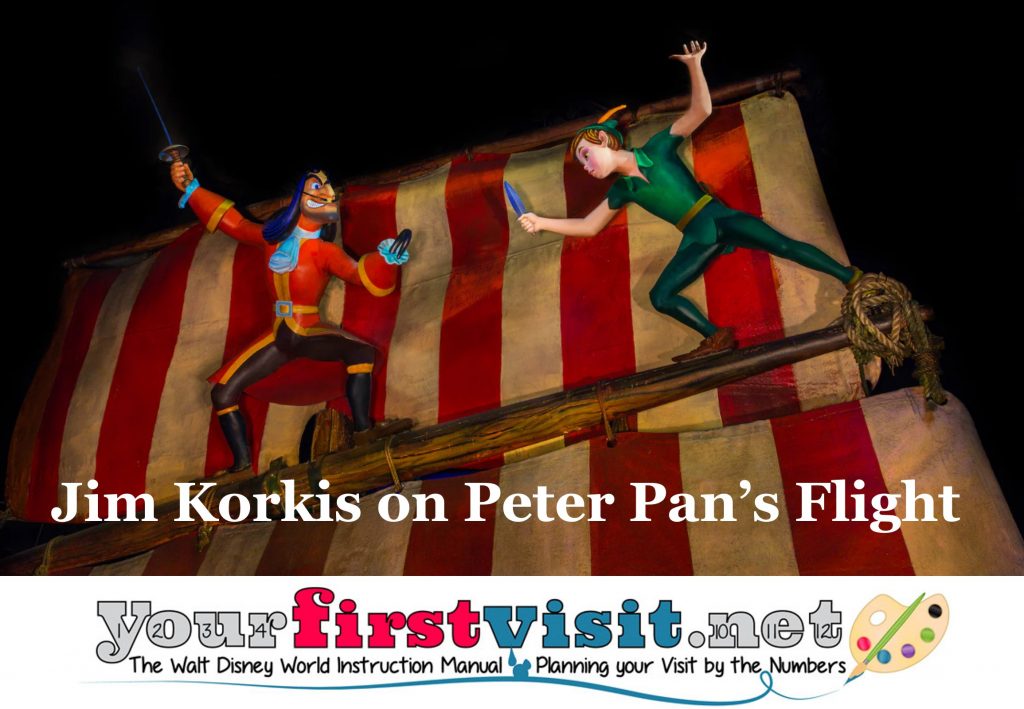Category — A Friday Visit with Jim Korkis
Fridays with Jim Korkis: Peter Pan’s Flight
Welcome back to Fridays with Jim Korkis! Jim, the dean of Disney historians, writes about Walt Disney World history every Friday on yourfirstvisit.net.
PETER PAN’S FLIGHT IN MAGIC KINGDOM
By Jim Korkis
Peter Pan’s Flight was an opening day attraction at Disneyland in 1955, and it became one of the company’s most popular and beloved attractions, later appearing in five Disney theme parks worldwide. A version did not open on opening day at Walt Disney World but rather two days later, and featured some significant differences from the California version.
It does use the same overhead monorail track system that lifts miniature pirate ships up into the air for an almost three minute dark ride journey through the story of Disney’s animated feature Peter Pan (1953). (That monorail track system is the same mechanics used in some warehouses to move large cargo from one area to another.)
Guests fly out of the Darling nursery (some of the toy blocks spell out “Disney” and “Peter Pan”) into the night sky of London, with Big Ben and the Tower Bridge down below. Then it is off to Never Land and finally to Captain Hook’s Jolly Roger pirate ship where the pirate captain is battling with Peter Pan who is trying to save the Darling family and the Lost Boys.
The original concept for the Disneyland Fantasyland dark rides was that the guests were supposed to imagine themselves as the main character, so no Snow White figure appeared in her attraction, and no Peter Pan in Peter Pan’s Flight. The Walt Disney World version revised that concept that had confused guests for years by adding figures of the name characters.
Imagineers Bill Justice and Bill Martin corrected other things as well, since the Disneyland version lacked the Indians, Lost Boys and pirates on the ride. The Walt Disney World formatting was very similar to Disneyland’s ride with some upgraded effects and additions. One of the most iconic scenes from the Disney animated film was also included on Peter Pan’s Flight in Magic Kingdom, Captain Hook balanced precariously over the jaws of the hungry crocodile.
Some of these changes were later added to the Disneyland attraction in 1983.
To make the moving cars in the city of London seem like their headlights are approaching and receding, progressively larger dots of luminescent paint was used on a constantly moving bicycle chain.
The clouds floating over London were originally just plastic bags. The bubbling volcano lava was created using aluminum foil and creative lighting that was an Imagineer Yale Gracey innovation later used in the Pirates of the Caribbean.
The highest point in the attraction is seventeen feet, but it appears much higher thanks to the forced perspective of the buildings below.
Because of its high popularity and low ride capacity with usually only two people on a ship, the attraction usually featured the highest wait times, running up to an hour and a half. To help alleviate some of that frustration, in 2014 the restrooms next to the attraction were removed and replaced with an interactive queue.
The new standby queue line has guests weave through a winding hallway of the Darling family home with paintings depicting scenes from the film and then moving into the children’s nursery. It is here where guests can start to track Tinker Bell’s pixie dust light as she flies around and creates mischief with physical objects like a lamp, a chest, a globe and many more.
Guests get a chance to interact with shadow butterflies and shadow bells that actually ring when touched in addition to the lively shadow of Peter Pan and Tinker Bell popping up, among other surprises in the queue line.
A calendar in the queue has the date December 27, 1904 circled, a reference to the day when the original Peter Pan play by James Barrie commenced performances in London.
The attraction captures a sense of nostalgia and magic missing in some more recent rides.
* * * * *
Thanks, Jim! And come back next Friday for more from Jim Korkis!
In the meantime, check out his books, including his latest, Disneyland Historical Highlights!
July 16, 2022 No Comments
Fridays with Jim Korkis: Asia in Disney’s Animal Kingdom
Welcome back to Fridays with Jim Korkis! Jim, the dean of Disney historians, writes about Walt Disney World history every Friday on yourfirstvisit.net.
DETAILS OF ASIA IN DISNEY’S ANIMAL KINGDOM
By Jim Korkis
Asia, the first expansion area added to Disney’s Animal Kingdom, opened in 1999. Just as the park’s Africa section is set in the fictional village of Harambe, guests to Asia find themselves in the tiny fictional Kingdom of Anandapur. The area echoes architectural themes from India, Nepal, Indonesia and Thailand.
“One of the deepest impressions made on the Walt Disney Imagineers creative team during research trips to Asia was the way that many Asian cultures integrate their secular lives with their spiritual lives,” stated John Kavelin, WDI senior show producer. “The sacredness of life is reflected in the way they decorate their homes, public buildings, and trees.”
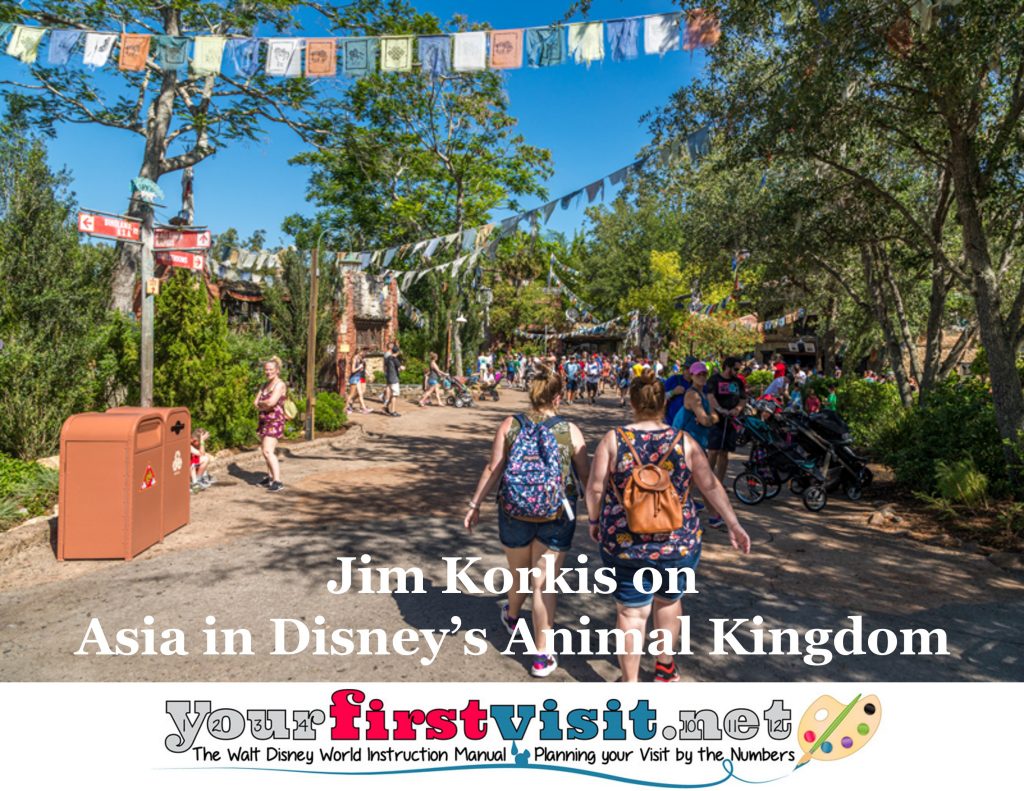
image (c) Josh
It took extra effort for Imagineering to bring that sacred, spiritual aspect of Asian culture to this area of Disney’s Animal Kingdom without favoring any one practice over another, so Imagineers respectfully wove elements of many different cultural traditions into the details.
The bollard lights around the north gibbon temple are shaped like Thai spirit shrines. In Thailand, these shrines would be found in every garden. A Nepalese design was used for similar lighting elements in the Maharajah Jungle Trek, although they were actually hand carved in Bali.
The back story for Asia tells of the Chakranadi River that is born from the snowmelts in the Himalayas. Its nurturing waters soon reach warmer regions, where it feeds the dense jungle resulting in unrestrained growth everywhere in Anandapur, especially the numerous trees.
The four decorated trees throughout the Asia area represent spiritual traditions in Asian culture. Typically, a grand old tree may be draped in honor of its venerable spirit or for loved ones who have departed this life.
People often say prayers at the tree then drape it in colored garlands or sashes. If the prayers are answered, the people return to hang bells near their garland. Tradition declares that the cloth must remain hanging no matter how old or tattered it gets.
To simulate this practice, WDI used faded cheesecloth (indicating that these were older garlands) as well as multicolored fabrics from India and Singapore, and bells from Indonesia, India and Nepal. The first cast members working in the area hung cloth on some of the trees.
According to Imagineers, “The flags represent messages of strength, wisdom, peace, and compassion, while the scarves pay homage to loved ones who have departed. When the wind blows, the message is spread to the fabric of the universe.”
“We’ve combined multicultural approaches to honoring the spirit of the trees,” said Kavelin.
Those accurate draping of the trees owed much to Vijay Sharma, who was a park security guard working the Maharajah Jungle Trek. She was from India, and she told Kavelin and his team that she could help drape the trees with prayer flags from her own personal experience in doing so, and they eagerly accepted her offer.
She could also read the Nepalese and Indian news clippings that were used to paper the ceiling of the entry building to the Maharajah Jungle Trek.
“She proved absolutely invaluable to the accuracy of Asia,” said Kavelin. “She helped edit out newspaper articles that were inappropriate. One turned out to be about a political assassin.”
Vijay also helped the team of Imagineers write labels on crates and packages and correct spellings and terminology. As a tribute to her assistance, she was cast as the face in the Kali River Rapids attraction.
* * * * *
Thanks, Jim! And come back next Friday for more from Jim Korkis!
In the meantime, check out his books, including his latest, Disneyland Historical Highlights!
July 8, 2022 No Comments
Fridays with Jim Korkis: Mouse Gear to Creations
Welcome back to Fridays with Jim Korkis! Jim, the dean of Disney historians, writes about Walt Disney World history every Friday on yourfirstvisit.net.
FROM MOUSE GEAR TO CREATIONS
By Jim Korkis
When Epcot opened on October 1, 1982, the park’s largest store was called Centorium. It combined the two words “Century” and “Emporium”.
Epcot was to lead guests into the new 21st century and “emporium” is a place where goods are bought and sold, which is why the big store in the Magic Kingdom is called by that name. So the Epcot store was meant to represent a retail location for the new century.
It had a large ground floor and a smaller upper level reached by stairs or a glass elevator. As the Millennium Celebration started to approach, Walt Disney World closed the store, removed the upper level as a shopping venue and added more space to the ground floor.
It reopened in September 1999 as Mouse Gear, the largest in-park merchandise location of any Disney theme park at that time worldwide. The name Mouse Gear also combined two words: Mouse referring to Mickey Mouse and Gear referring to a toothed wheel used in machinery as well as “gear” referencing equipment and clothing.
Guests were surrounded by the sights and sounds of machinery at work. Colorful gears, pistons, levers and belts created a theme of production and activity.
Imagineer Agnes David-Hoffman was the art director and principal designer of the store. When it opened, she stated, “It’s a perpetual merchandise machine. This is the place where all the great ideas for merchandise are happening…where all of that production is happening. Not only is this going to be retail entertainment, it’s also meant to be an attraction for the guests.”
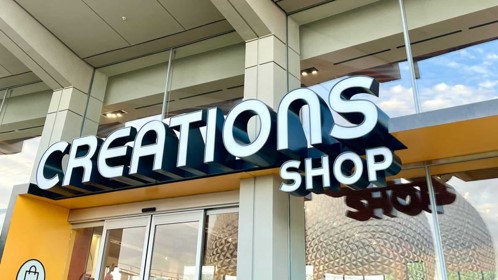
(c) Disney
The Imagineering storyline was that Mickey Mouse and his friends use this “factory” to create all the merchandise for the Walt Disney World Resort.
There were four different entrances surrounding the building.
One of the entrances was meant to be the “shipping” section where characters send the merchandise to other places on property. In this section was a giant icon in the shape of Mickey Mouse’s hand suspended overhead and a series of mechanical pieces styled to look like famous Disney characters on the wall.
As the Mickey icon moved clockwise from above, pointing at the different wall pieces, the mechanisms came to life with moving gears, gauges and sounds as the merchandise is sprinkled with the last piece of important material…pixie dust.
Imagineers created a special soundtrack to run in part of the store featuring a combination of industrial sounds that had been formatted into a rhythm or song. In addition, classic Disney songs were played.
The second level was styled to resemble the office of the factory with one section featuring frosted window silhouettes of Donald Duck, Scrooge, Daisy Duck and the nephews, that had also a loop of dialog indicating not everything was going well. Behind those windows were the actual store’s merchandise management team’s offices.
Hanging overhead and often unnoticed by busy shoppers was Dreamfinder’s Dreamcatcher from the Journey Into Imagination attraction that had closed.
Mouse Gear closed January 4, 2020 and was replaced by the Creations Shop that opened September 15, 2021 as part of the big EPCOT Transformation project announced in 2019.
The new store does not have an immersive storyline but features merchandise that embodies the “bold, sleek design” of EPCOT with large glass walls to connect guests with the bright outdoors.
Since Mickey Mouse is “the symbol of creativity for the Walt Disney Company”, the store was named “Creations” and features an oversized mural of Mickey Mouse as well as other designs and murals paying tribute to the iconic character.
* * * * *
Thanks, Jim! And come back next Friday for more from Jim Korkis!
In the meantime, check out his books, including his latest, Disneyland Historical Highlights!
July 1, 2022 No Comments
Fridays with Jim Korkis: Not Just a Walk in the Park
Welcome back to Fridays with Jim Korkis! Jim, the dean of Disney historians, writes about Walt Disney World history every Friday on yourfirstvisit.net.
YOUR PERSONAL DISNEY LIBRARY (53)
By Jim Korkis
- Not Just a Walk in the Park: My Worldwide Disney Resorts Career by Jim Cora with Jeff Kurtti
I am a huge advocate for trying to get some of the Disney “old timers” who were there in the earliest days of Disneyland and Walt Disney World to share their memories of those times into print.
We have already lost so many who had unique perspectives and experiences, and their stories are now lost forever. So like many Disney fans and historians, I was excited to see that Not Just a Walk in the Park by Jim Cora was to be published, and to underline my feelings of urgency, he passed away March 2021, just months before this book was released.
Jim Cora was made a Disney Legend in 2005 and has his name on a window on Main Street at a couple of Disney theme parks. He started as a part time attractions host at Disneyland in 1957, but at the personal urging of Walt Disney he moved into management training where he was mentored by Van France. By 1971, he was part of the opening team of the Magic Kingdom and by 1979 was managing director for the Tokyo Disneyland project.
Not Just a Walk in the Park is a conversational, anecdotal memoir of Cora’s remarkable four decade career with the Walt Disney Company, especially its expansion internationally. He was beloved and respected by all of those he worked with at Disney.
For those focused only on Walt Disney World, only one of the eleven chapters is devoted to that park in this 192 page book, and that chapter doesn’t offer much new information.
However the chapter, like the others, does include never-before-known bits of information tossed in casually, like the fact that he was in charge of Fantasyland on opening day, but had forgotten to place an order for ticket boxes at the attractions, so that day cast members put the torn tickets into their pockets or nearby trash cans until the situation could be rectified.
I did, however, learn much more about Disneyland Paris and Tokyo Disneyland than I had known previously, and Cora was also a consultant to Shanghai Disneyland even after he retired.
The “with Jeff Kurtti” credit is significant because I have been in the situation of trying to help a few Disney Legends write their stories and it is challenging with faulty memories, especially of names and dates, and just not the skill to communicate their stories effectively.
Kurtti is one of the most respected of Disney historians and a very good writer in his own right, and the fact that the text is so accurate and flows so smoothly are probably the result of his handiwork.
Each chapter is broken up into “bite-sized” sections that make the text less intimidating and easier to find some specific information—helpful, since there is no index.
A nice touch is that the middle of the book has fifteen pages filled with multiple personal photos on each page (mostly color) that I certainly had never seen before in any previous book or magazine.
With Dick Nunis’ book from Disney Editions coming out this year, I was intrigued by Cora’s comment that while he agreed with what Nunis was trying to accomplish when he ran the parks, he sometimes disagreed with how Nunis was going about accomplishing it. I think that is an insightful and accurate impression of a very controversial leader who Cora was friends with for a time.
Not Just a Walk in the Park is for those who love Disney parks history and would like to hear from someone who knew and worked with both Walt and Roy Disney and is credited for paving the way for the success of the foreign Disney theme parks.
* * * * *
Thanks, Jim! And come back next Friday for more from Jim Korkis!
In the meantime, check out his books, including his latest, Disneyland Historical Highlights!
June 26, 2022 No Comments
Fridays with Jim Korkis: Walt Disney World Fireworks
Welcome back to Fridays with Jim Korkis! Jim, the dean of Disney historians, writes about Walt Disney World history every Friday on yourfirstvisit.net.
WALT DISNEY WORLD FIREWORKS
By Jim Korkis
The Walt Disney Company is the largest consumer of fireworks in the world (and the second largest purchaser of explosive devices, right behind the U.S. Department of Defense), deploying well over a million individual fireworks annually (Epcot alone uses over 750 shells every night in its show).
The Fantasy in the Sky Spectacular took place in celebration of the dedication of the Polynesian Village Hotel (now Disney’s Polynesian Village Resort) on Oct. 24, 1971, making it the first Walt Disney World night time fireworks show.
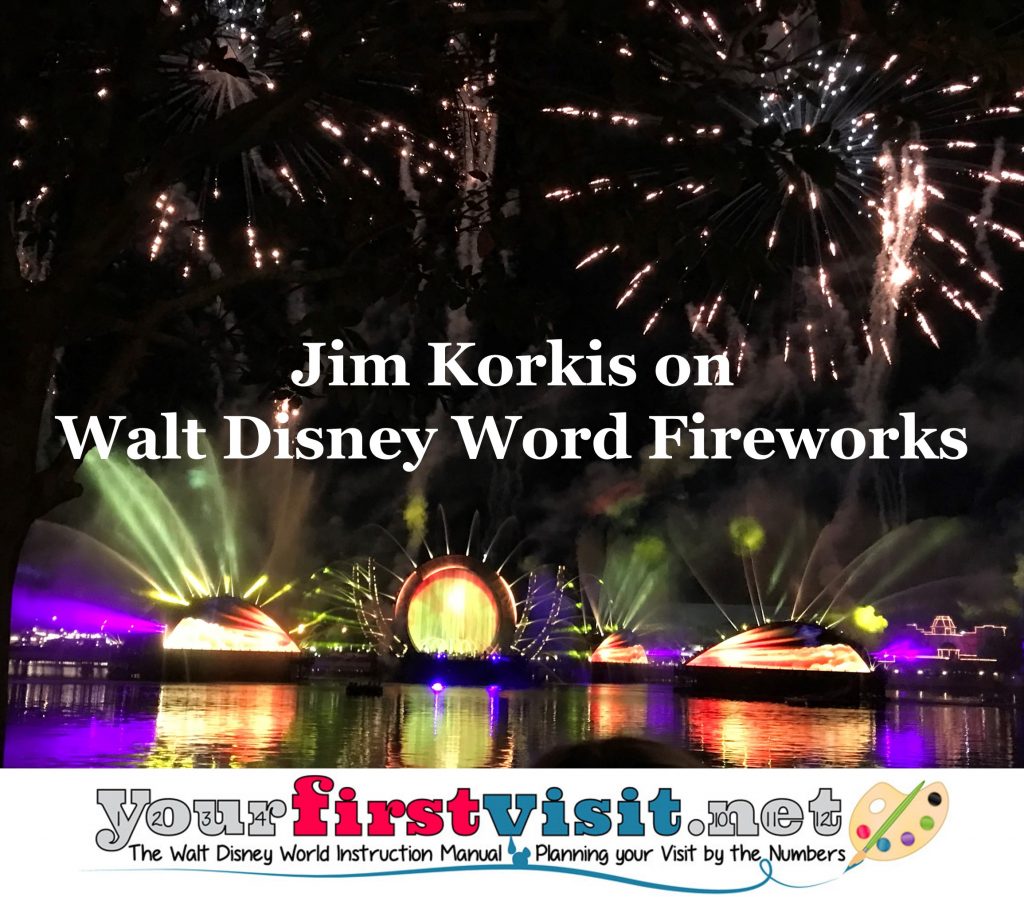
Guests can find fireworks displays at Magic Kingdom, EPCOT, and Disney’s Hollywood Studios. Only Disney’s Animal Kingdom does not have a fireworks show, because it was determined that the loud noises and bright lights in the sky would bother the animals and disrupt their sleep schedule.
Several teams are involved, including Safety, Entertainment Fireworks Storage Facility, Fireworks and Special Effects, and the Reedy Creek Emergency Services, spending months in preparation to make sure that the Entertainment stage technicians can deliver the finest fireworks displays safely every day.
Starting in 2004, to launch the projectiles Walt Disney World uses a compressed air system that ensures a higher launch with greater accuracy and consistency, as well as reducing unwanted noise. It also eliminates gunpowder fumes. Since fireworks do indeed still burn, guests may smell fumes, but not irritating gunpowder.
Walt Disney World parks change their fireworks offering regularly, constantly trying to “top” the previous show in terms of visual display, music and more. The nighttime park shows last roughly fifteen minutes or a little more.
Over the years many fireworks spectacular shows were developed for outside the parks but still on Walt Disney World property:
Merriweather’s Nighttime Fireworks Show: One early concept in 1987 by independent consultant Michael Kennedy was a nighttime fireworks show on the water surrounding Pleasure Island to be called “Pleasure Island Pyrotechnical Exposition.”
Supposedly, Merriweather Pleasure built another steamboat, the Pleasure Island Princess. This ship was blown up by greedy cousins who set alight fireworks (stolen supposedly from the Fireworks Factory on the island) in the belief that Pleasure was mis-using their eventual inheritance on such folly. The phantom ship piloted by a ghostly Merriweather Pleasure would re-appear each evening (or at least the sound of the steamship) and would vanish in a final flurry of showering fireworks.
Noah’s Ark was announced to be “the most ambitious nighttime spectacle in Disney Theme Park history” to open in 1992. It would have been staged on the waters of Crescent Lake, primarily for the delight of the guests staying at the deluxe Walt Disney World Resorts there, the Boardwalk and Yacht and Beach Clubs, situated around that body of water.
Storyboards were created, and models were built. Award winning composer Andrew Lloyd Webber wrote the score.
There would be huge floating stages with miles of neon tubing so that the colorful lights could be easily seen. Disney officials even considered moving the show to then-named Disney-MGM Studios to be the East Coast version of the popular Disneyland Fantasmic! Show. Eventually, it was decided just to re-create a version of Fantasmic for Florida.
Webber also worked on another grand spectacle show for WDW titled “EQ” that centered around horses, but it, too, never came to life. Don Frantz, responsible for producing and directing the Walt Disney World nighttime parade SpectroMagic, managed the conceptual development of both the proposed Webber shows.
“At the time, we were talking about doing all kinds of different spectaculars,” said Imagineer Eric Jacobson. “You could say that the basic thinking behind them was one of the keys that led the way to Disney’s foray into Broadway.”
* * * * *
Thanks, Jim! And come back next Friday for more from Jim Korkis!
In the meantime, check out his books, including his latest, Disneyland Historical Highlights!
June 17, 2022 No Comments
Fridays with Jim Korkis: Pixie Hollow
Welcome back to Fridays with Jim Korkis! Jim, the dean of Disney historians, writes about Walt Disney World history every Friday on yourfirstvisit.net.
PIXIE HOLLOW
By Jim Korkis
The Disney Fairies franchise was a new concept launched in 2005 to try to start another profitable enterprise like the Disney Princess franchise for the Walt Disney Company.
Tinker Bell and her newly created fairy friends were to focus on girls younger than the demographic for the princesses, or roughly six to ten years old, to try to compete with the Barbie franchise of Fairytopia that included DVDs, books, games and more.
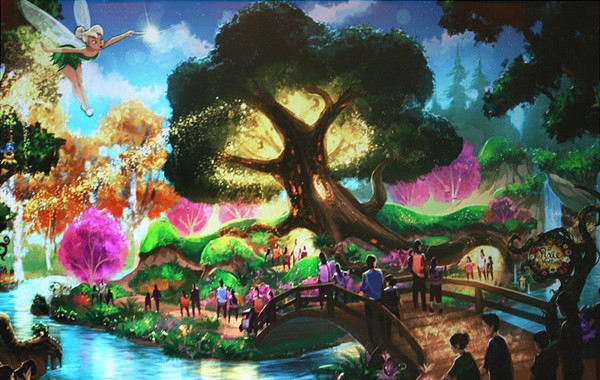
(c) Disney
Pixie Hollow is located in the mountains in the north of Neverland, where all four seasons co-exist at the same time and are each presided over by a Seasonal minister. Areas include Spring Valley, Summer Glade, Autumn Forest and Winter Woods.
The entire area has been ruled for hundreds of years by the regal Queen Clarion. The Pixie Dust Tree is located at the center of Pixie Hollow and it is where the fairies get their pixie dust each day to perform their various tasks.
The franchise was supported by multiple books, games, an online presence, toys and more. In 2008, the first straight-to-video movie entitled Tinker Bell was released, introducing a wider audience to the stories of Pixie Hollow.
The Walt Disney Company felt that to better take advantage of the franchise, there should be a physical Pixie Hollow location in the Disney Parks where young girls and other guests could meet the fairies and get autographs and photos.
In October 2008, two Pixie Hollow meet-and-greet locations were opened at Disneyland, at the entrance to Tomorrowland where the previous Ariel’s Grotto was located and changing the rotating mermaid seashell into Tink’s teacup house, and at Walt Disney World’s Mickey’s Toontown Fair where other character meet-and-greets took place.
The premise was that going through the entrance to the area, guests shrunk to the size of fairies or roughly six inches tall and once they left, they were restored to their normal size.
Another version opened at Hong Kong Disneyland in January 2011 as part of that park’s fifth anniversary celebration. At all locations, guests had the opportunity to meet Tinker Bell herself and at least one of her fairy friends: Silvermist, Rosetta, Iridessa, Fawn, Terence and Vidia, and others.
The Walt Disney World location closed in February 2011 for the expansion of the New Fantasyland. The original plans that were announced for the New Fantasyland included a larger, more elaborate Pixie Hollow location, but that was abandoned along with other expansion plans including individual areas for several Disney princesses. The feedback from guests was that the plans were too “girl-centric”.
Alternate proposals then suggested including Pixie Hollow as part of Epcot’s Flower and Garden Festival in the side pathway that leads to the entrance of the World Showcase. If it were popular, like other temporary Flower and Garden additions like the miniature train in Germany, it would be made permanent.
It was also suggested to become part of Disney’s Hollywood Studios, because of the film connection, but neither of these proposals happened.
Tinker Bell and her fairy friends eventually returned to Walt Disney World in July 2011 in Tinker Bell’s Magical Nook located in the Adventureland Veranda. It later closed in 2014 to make room for the Skipper Canteen restaurant. The fairies can now be greeted at the Town Square Theater on Main Street.
* * * * *
Thanks, Jim! And come back next Friday for more from Jim Korkis!
In the meantime, check out his books, including his new books Vault of Walt: Volume 10: Final Edition, Kungaloosh! The Mythic Jungles of Walt Disney World and Hidden Treasures of Walt Disney World Resorts: Histories, Mysteries, and Theming, much of which was first published on this site.
Follow yourfirstvisit.net on Facebook or Twitter or Pinterest!!
June 10, 2022 No Comments

